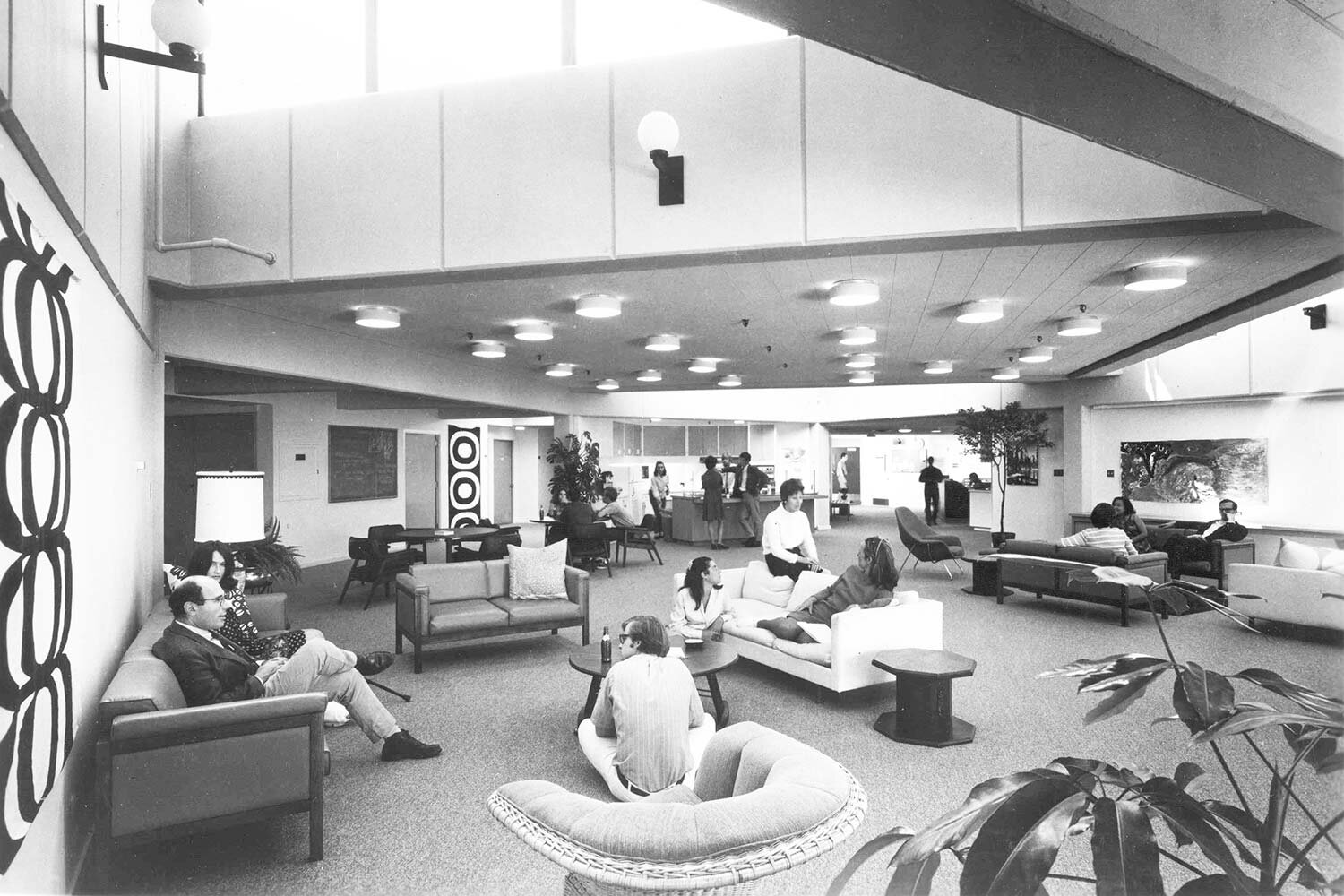Hawaii State Hospital Forensic Facility, Kaneohe, HI, 2021 (LEED Silver)
KMD has developed a design philosophy responsive to changes in the delivery of care for behavioral health services since 1963.
It was then that the founders of the firm collaborated with psychiatric professionals to conduct research under a grant from the National Institutes of Health (NIH) that was subsequently published in the book, “Programming, Planning and Design for the Community Mental Health Center.” The book served as a guide in the creation of an entirely new approach to the planning and design for behavioral health facilities. The premise was based on the theory that providing integrated open space that is varied in plan and section—that the building architecture itself—could have a positive therapeutic effect on patients’ psychiatric well-being. KMD put this premise to the test when designing its first Mental Health Centers and Post-occupancy evaluations of KMD facilities have validated the concept.
Marin General Mental Health Center (1960s)
KMD’s design philosophy remains ahead of the curve and is aligned with new methodologies for mental health care delivery. Smaller community-based facilities, with an emphasis on therapy and counseling and shorter patient stays have replaced large state-run institutions employing behavior modification and rehabilitation.
Aristo IBHTF, Renton, WA, 2023 (left) | North Sound Behavioral Health Facility, Everett, WA, 2021 (right). Both are adaptive reuse projects.
New Generation of Mental Health Facilities
New legislation and funding at the state level offer a plethora of opportunities to create a new generation of facilities, either within repurposed buildings and/or new construction. Federal, state and county governments have also seen fit to build new, secure, and culturally sensitive hospitals for wards of their judicial, or forensic systems. Recent KMD project examples in Hawaii and California address long neglected needs among women and indigenous populations through planning and design innovations specifically responsive to and supportive of cultural expectations and climatic conditions. Our unique, comprehensive campus design in Dubai incorporates similar ambitious goals within the realities of a harsh climate, for the multicultural, ethnic, and religious peoples of the United Arab Emirates.
Hawaii State Hospital Forensic Facility, Kaneohe, HI, 2021 (LEED Silver) | Al Amal Psychiatric Hospital, UAE, 2017
Existing, long-term providers of mental health care must also respond to demands for growth, improvement and/or replacement of aging facilities. KMD’s exemplary repurposing and conversion of an obsolescent acute care hospital floor into a state-of-the-art psychiatric environment for the relocation of the University of California at San Francisco, Langley Porter Psychiatric Hospital successfully co-locates three inpatient and outpatient programs. The ability to undertake the project within an alternative UCSF campus avoided the time necessary to identify and purchase a new site and obtain neighborhood approvals. The project minimized it’s ecological footprint and integrated LPPH within a highly accessible, central city neighborhood.
UCSF Langley Porter Psychiatric Hospital, San Francisco, CA, 2023
Myriad factors influence the types and character of envisioned new facilities including:
Patient diagnosis & safety | Lengths of stay | Community accessibility | Payor mix | Ownership | Codes & regulations
Important decisions affecting programmatic goals and/or compliance with economic realities will determine the ratios between single care and shared bedrooms, the level of security features necessary, as well as foster an innovative environment to fulfill the goals and aspirations for an increasingly diverse, equal, and inclusive patient population.
In response, new models of care have emerged, such as the various classifications of supportive housing and residential treatment enacted by the State of Washington to fill gaps in the continuum of care. Facilities such as Intensive Behavioral Health Treatment Facilities (IBHTF) and Enhanced Services Facilities (ESF) provide longer term residential treatment for patients who require longer hospitalization but are not yet ready to re-integrate into their communities. Also new models of care have appeared in the outpatient setting as well. One such example is the Intensive Outpatient Treatment program which allows patients an opportunity to live within a structured, hotel-like environment wherein they may take a longer time to rehabilitate before reentering the community.
Mark Reed E+T, 2019 (left) | Parks Place ESF, 2023 (center) | Aristo IBHTF, 2023 (right). Mark Reed E+T & Aristo IBHTF are adaptive reuse projects.
Today’s goals trend toward longer term residential facilities that support rehabilitation within smaller groups. The increased availability of funding for new programs has resulted in more of these smaller residential care facilities with home-like settings. As a firm, KMD has current experience designing several similar facilities for county behavioral health organizations and regional clients within the State of Washington. They range from 16-bed residential facilities for evaluation and treatment, to a 120-bed behavioral health hospital in Tacoma, Washington, sponsored by two large hospital systems serving the South Puget Sound area. The latter facility, the Wellfound Behavioral Health Hospital, provides comprehensive services including a crisis stabilization unit, outpatient clinic, and inpatient units for varying acuity levels, all serving small groupings of patients.
Wellfound Behavioral Health Hospital, Tacoma, WA, 2019
To meet programmatic needs and limits on reimbursement for care, KMD has evolved a variety of architectural solutions from new construction through the renovations of existing buildings, which include:
Building a new facility for an Enhanced Services Facility (ESF).
Reopening & renovating an abandoned, rural hospital as an Adult Evaluation & Treatment Facility (E+T).
Renovating & expanding an underutilized Juvenile Detention Facility into Adult Behavioral Health & Chemical Dependency Treatment Facilities.
Repurposing a commercial office building to house an Intensive Behavioral Health Treatment Facility (IBHTF).
Renovating a hospital floor into a 30-bed secure inpatient unit & stepdown outpatient services.
In each case KMD has provided settings conducive to rehabilitation and healing for behavioral health patients in need, and/or structured & supportive housing as they transition into the community.
A current trend which is enhancing the access and delivery of behavioral health treatment is the Medical Home concept, integrating behavioral health with other basic healthcare services within a single location to achieve a model of care which treats the whole patient. An added benefit is that such increased visibility helps destigmatize behavioral health treatment. KMD has recently renovated several outpatient behavioral health clinics to incorporate primary care and create medical homes. We also recently completed a new wellness center with medical, dental, behavioral health services and community space for the Lummi Nation of Northern Washington, whose culture has historically utilized the ‘whole person’ model of care.
Lummi Nation Wellness Center, Bellingham, WA, 2024
Cost Effective & Operationally Efficient Facilities
As organizations compete for funding for constructing facilities and delivering care at a competitive cost, the consideration with the greatest impact on construction cost is the choice between all private versus all semi-private patient rooms.
The all-private room model simplifies bed assignment in mixed gender units, avoids roommate conflicts and provides a quieter environment. However, space requirements per patient for single rooms with toilets require, on average, 45% more area than an all-semi-private model for the same number of patients. In addition to added cost for building, operating, staffing, and maintaining a larger all-private room facility results in higher costs over the life of the building. Consequently, many providers construct facilities with all or a majority of semi-private patient rooms, supporting a claim by many clinicians who believe that semi-private rooms provide greater safety, by eliminating the one area where in a patient is left alone for an extended period of time.
Patient rooms: UCSF Langley Porter Psychiatric Hospital (single & double) | Aristo IBHTF (double)
KMD planners and designers recognize the clinical benefits of the all-private model as well as the cost benefits of the semi-private model. Hybrid solutions provide compromise with higher acuity patients in all-private rooms, and all semi-private rooms for recovering patients. At the recently completed Forensic Facility for Hawaii State Hospital, on Oahu, the Admissions and High-Risk Units offer only single care rooms with on-suite toilet/shower rooms, while the lower acuity units offer, predominantly double rooms with shared bathing facilities, accessed from the corridor.
Outdoor Access as a Focus of Design
Our design teams strive to integrate interior and exterior spaces, thereby maximizing patient choice without compromising safety or security. Exterior activity areas are planned to be highly visible from staff duty stations, freely accessible to patients for extended hours and soothingly landscaped. Even within highly restrictive forensic facilities and/or tight urban sites, KMD prioritizes access to outdoor exercise, fresh air, daylight and vistas of nature for patients and staff alike.
Hawaii State Hospital Forensic Facility (left) | UCSF Langley Porter Psychiatric Hospital (right)
Hawaii State Hospital’s recently completed Forensic Facility is a secure hospital which best exemplifies KMD principles to maximize daily patient access to outdoor spaces, as well as views of imposing nearby hills, dense vegetation, and a distant seashore. Building upon Hawaii’s climactic and cultural preferences for living outdoors, open air spaces are integrated throughout the facility within screened ‘lanais’, covered breezeways and lush gardens and courtyards. KMD has created a sense of community surrounding a ground level Treatment Mall; wherein patients participate in full-day occupational therapy and treatment programs.
Within residential units (and specifically for patients not yet allowed to access the Treatment Mall) patients enjoy unlimited access to secure, partially covered patios visible from duty stations, as well as limited access to large outdoor spaces for supervised physical games and activities. The Admissions and High-Risk Units offer self-contained occupational and treatment zones, accessible within secure courtyards, supervised from staff work stations.
Hawaii State Hospital Forensic Facility (LEED Silver)
Paired residential units on three upper floors achieved construction and operational economies through shared staff support spaces, conference rooms, lockers, lounges, lanais, and central suites of family visitation rooms (directly accessible from the entrance lobby through a secure, dedicated public elevator). Immediate assistance from nearby staff is available at all hours and considered of greatest importance during patient emergencies, especially during shifts with limited staffing.
As a polar opposite to Hawaii’s bucolic facility, the successful relocation of UCSF’s Langley Porter Psychiatric Hospital into the seventh floor of an urban hospital affords sweeping views of the cityscape, as well as patient access to a generous outdoor, waterproof porch within the building floor plate, heated for year-round use and made secure by transparent metal screens. A small nook alongside a large window offers a quiet space for personal respite and reflection, well protected from harsh winds.
KMD’s successful repurposing of obsolescent acute care wings for behavioral health indicates that similar opportunities may abound within older hospitals across the United States.
UCSF Langley Porter Psychiatric Hospital: (left to right) Therapy Room, Inpatient Therapy Corridor, Dining/Activity Room
Changes in behavioral health care towards residential settings has positively impacted beyond the treatment centers themselves, driving the development of new products for behavioral health environs, less institutional in appearance while retaining necessary features for durability and safety. Safe environments for patients, staff and visitors must be customized within each facility, commensurate with the anticipated levels of illness and asocial behavior among patients, through the elimination of opportunities for self-harm and potential ligature. KMD’s broad experience in behavioral health design has led us to develop tools to assist owners to evolve a comprehensive program of the safety and design features matched to the facility’s needs.
For more than 60 years, KMD has designed and built more than eighty behavioral health facilities. Our design philosophy has evolved to support and enhance successive models of care delivery and has informed our designs across the full spectrum of care from telepsychiatry, community and forensic treatment facilities. As the transformation of behavioral health care delivery has improved treatment transparency and improved access to care, the stigma long associated with mental health treatment has diminished, encouraging many to seek treatment who may have avoided care previously, thereby contributing to a healthier population.
kmd behavioral health projects
©kmd architects 2024
To learn more about KMD’s Behavioral Health Care practice contact Chris Rubright.
email | 206.812.5612












